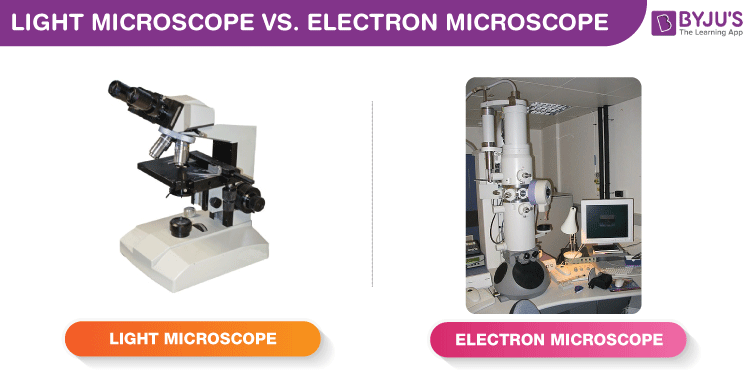
Microscopes are available in different sizes and for particular usage. The most common types of microscopes are the light microscope and electron microscope. Each of these microscopes possesses distinct features and is appropriate for different purposes. Both light microscopes and electron microscopes use radiation to form detailed images of objects that a human eye cannot produce unaided. The main difference between them is that in an electron microscope, a beam of electrons is used for magnifying the image of an object while visible light is used in the light microscope to magnify images of tiny areas of materials or biological specimens. Differences between an electron microscope and a light microscope are listed below in a tabular column.
Light Microscope vs Electron Microscope
| Difference Between Electron Microscope and Light Microscope |
| Light Microscope |
Electron Microscope |
| Uses light (approx. 400-700 nm) as an illuminating source |
Uses electron beams (approx. 1 nm) as an illuminating source |
| Lower magnification than an electron microscope |
Higher magnification |
| No risk of radiation leakage |
Risk of radiation leakage |
| Specimen preparation takes about a few minutes or an hour |
Specimen preparation takes several days |
| Both live and dead specimens can be seen |
Only dead and the dried specimen can be seen |
| The image formation depends upon the light absorption from the different zones of the specimen |
The image formation depends upon the electron scattering |
| The image is seen through the ocular lens. No screen needed |
The image is received on a zinc sulfate fluorescent screen |
| Useful magnification of 500x to 1500x |
Direct magnification as high as 16000x and photographic magnification as high as 1000000x |
| Low resolution |
High resolution |
| Inexpensive and requires low maintenance cost |
Expensive and high maintenance |
Though both microscopes are important in their own way, nowadays electron microscopes are widely used by scientists in laboratories for the detailed study of organisms while light microscopes are used by schools and colleges for viewing organisms that are easily visible through them.
Stay tuned with BYJU’S – The learning app to know more.

Frequently Asked Questions – FAQs
Q1
What is total internal reflection?
Total internal reflection is a phenomenon of reflection of a ray back to the same medium when passing from a denser medium to a rarer medium in such a way that the angle of incidence is greater than its critical angle.
Q2
What are the different types of microscopes?
The different types of microscopes are:
- Simple microscope
- Compound microscope
- Electron microscope
- Stereomicroscope
- Scanning probe microscope
Q3
What is a simple microscope?
A simple microscope is defined as the type of microscope that uses a single lens for the magnification of the sample. A simple microscope is a convex lens with a small focal length.
Q4
What is the working principle of a simple microscope?
The working principle of a simple microscope is that when a sample is placed within the focus of the microscope, a virtual, erect and magnified image is obtained at the least distance of distinct vision from the eye that is held at the lens.
Q5
What is a compound microscope?
A microscope with a high resolution uses two sets of lenses to provide a 2-dimensional image of the sample. The term compound refers to the usage of more than one lens in the microscope. Also, the compound microscope is one of the types of the optical microscope.



SO SHORT AND VERY HELPFUL. THANK YOU
Nice and marvelous lectures
very helpful – thank you